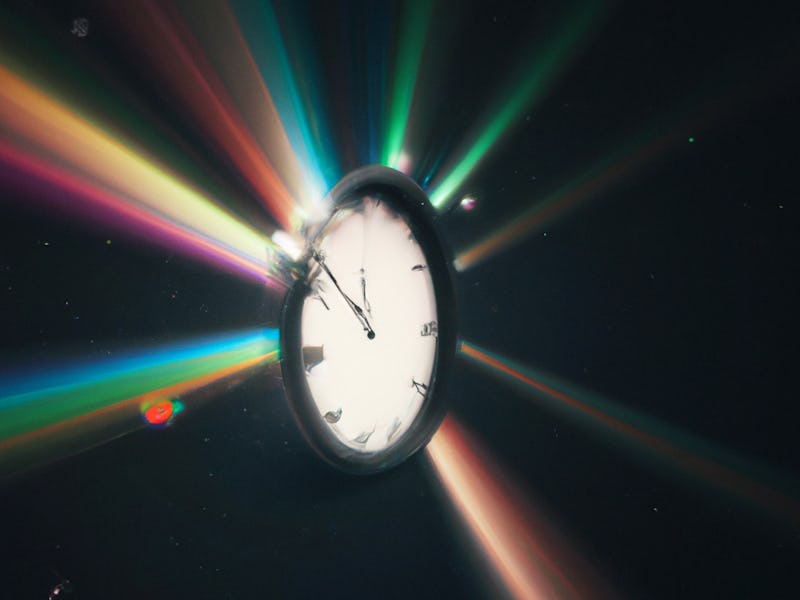Ground-Breaking Physics Experiment Shows Light Can Cross Through Gaps in Time
Quantum physics never ceases to impress.

Quantum physics is the realm of the strange. And one of the strangest discoveries in the field is also one of the most fundamental: Particles fired at barriers with two slits in them can act like waves and go through both openings simultaneously. For more than 200 years, “double-slit experiments” reveal particles can behave like waves, whether they are photons, electrons, neutrons, atoms, or even molecules made up of 2,000 atoms. Now, scientists have pushed the boundaries even further — and got weirder.
In a new version of the experiment, scientists made light cross through gaps not in space, but time. The findings, published Monday in the journal Nature Physics, could lead to new, unusual ways to control light, such as photonic time crystals — something that creates patterns in time with light — for potential applications in super-powerful quantum computers.
“The experiment is neat,” says Andrea Alù, an electrical engineer at the City University of New York’s Graduate Center, who did not take part in this research.
Wave or particle?
Isaac Newton performed many experiments with light. He believed light was made up of particles — a view that dominated physics until the 19th Century.
The confusion over whether light is a wave or particle goes back centuries. In the 18th century, Isaac Newton argued that light was composed of particles, while his contemporary Dutch physicist and astronomer Christiaan Huygens suggested light traveled in waves.
Newton’s fame led his view to dominate physics for about a hundred years. Then, in 1801, British polymath Thomas Young devised the double-slit experiment. His tests revealed that light shining through a barrier with two closely spaced parallel slits could generate repeating bands of light and dark on a wall on the other side. This is what one might expect from overlapping waves — where peaks of the waves meet, they strengthen each other, but where a peak and a trough meet, they cancel each other out, resulting in a series of stripes of more and less light.
But in 1905, Albert Einstein discovered that light can also behave like particles. Quantum physics later revealed that light is both particle and wave, not simply one or the other. This particle-wave duality applies to all known particles and waves — basically, Huygens and Newton were both right, to an extent.
Patterns in time
The scientists used a material usually found in phone touchscreens.
The scientists experimented with indium tin oxide, an electrically conductive transparent material regularly found in cell phone touchscreens. When an intense laser pulse hits a thin layer of this compound, it becomes a mirror for a tiny fraction of a second.
The classic version of the double-slit experiment uses two openings in a physical barrier for light to squeeze through, this new device could switch how reflective it was to light. The researchers called these small temporary openings in the material "time slits."
In order to generate interference patterns from a double slit in time, the device the physicists used has to switch its reflectivity extraordinarily quickly, on time scales comparable to how fast light oscillates — a few femtoseconds, or quadrillionths of a second. “If the entire history of the Universe from the Big Bang to the moment you read this was a second, an oscillation of light would only take the equivalent of a single day,” study lead author Romain Tirole, a physicist at Imperial College London, tells Inverse.
The researchers conducting their version of the double-slit experiment.
The scientists found that a beam of light passing through such time slits diffracted or scattered into a number of frequencies or colors of light. These different frequencies could interfere with each other, strengthening or weakening some of them to generate an interference pattern, just as light does in the classic double-slit experiment. “We were very surprised by how clear it showed up on the detectors,” Tirole says of the pattern.
The evidence the researchers detected of this diffraction was much stronger than they had expected. This suggests indium tin oxide has a switching speed “10 to 100 times faster than previously thought, which enables a much stronger control of light,” Tirole says. This suggests there are new features about this material's interactions with light that “are still to be uncovered and exploited.”
Engineer Alù notes to Inverse it was “impressive to see how fast the material responds,” which suggests it may help lead to other experiments with time.
What’s next?
Quantum computing holds the potential to revolutionize technology and science.
These new findings highlight the novel ways in which researchers are increasingly tinkering with time. For instance, Alù and his colleagues recently demonstrated “temporal reflections” with light waves — when light signals passed through a “time interface,” they acted liked they were traveling backward in time.
Time slits and time interfaces may help scientists develop exotic new ways to control light, such as “photonic time crystals.” An ordinary crystal is a structure of many atoms arranged into a regular pattern in space, whereas time crystals are structures where many particles are ordered into regular series of motions—patterns in time rather than space. In a photonic time crystal, optical properties would vary regularly over time.
Photonic time crystals “could have very important applications for light amplification and light control — for example, for computation, and maybe even quantum computation with light,” Tirole says.
This article was originally published on